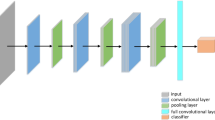Abstract
The paper proposes a technique that uses on ensembles of models for identifying remote sensing objects. As models, we consider a multilayer convolutional neural network, an ensemble of convolutional neural networks and SVM models, and a hybrid convolutional neural network. It is proposed to determine the optimal hyperparameters of the model by a mesh or random search methods using k-fold cross validation. A method for improving the accuracy of identifying objects with an ensemble of neural networks is shown. The results of an experiment using remote sensing data are presented. The problem of identifying objects of two classes is solved; images obtained with a synthetic aperture radar are used as the test data.





Similar content being viewed by others
REFERENCES
Large Scale Visual Recognition Challenge 2016 (ILSVRC2016) [Electronic Resource]. Available at http://image-net.org/challenges/LSVRC/2016/results (Accessed June 4, 2018).
I. Goodfellow, Y. Bengio, and A. Courville, Deep Learning, Adaptive Computation and Machine Learning Ser. (MIT Press, Cambridge, MA, 2016).
D. Parikh and R. Polikar, “An ensemble-based incremental learning approach to data fusion,” IEEE Trans. Syst. Man Cybern. Part B 37 (2), 437–450 (2007).
Y. Marushko, “Using ensembles of neural networks with different scales of input data for the analysis of telemetry data,” in Proc. XV Internship PhD Workshop OWD 2013 (Wisla, Oct. 19–22, 2013) (Silesian Univ. of Technology, Gliwice, 2013), pp. 386‑391.
N. Kourentzes, D. K. Barrow, and S. F. Crone, “Neural network ensemble operators for time series forecasting,” Expert Syst. Appl. 41 (9), 4235–4244 (2014).
T. Hastie, R. Tibshirani, and J. Friedman, The Elements of Statistical Learning: Data Mining, Inference, and Prediction, 2nd ed. (Springer, New York, 2009).
J. Bergstra and Y. Bengio, “Random search for hyper-parameter optimization,” J. Mach. Learn. Res. 13 (1), 281–305 (2012).
Statoil/C-CORE Iceberg Classifier Challenge. Data [Electronic Resource]. Available at: https://www.kaggle.com/c/statoil-iceberg-classifier-challenge/data (Accessed June 4, 2018).
D. P. Kingma and J. Ba, “Adam: A method for stochastic optimization,” in Proc. 3rd Int. Conf. for Learning Representations (ICLR, 2015) (San Diego, May 7–9, 2015). https://arxiv.org/abs/1412.6980
Funding
This work was partially supported by the Belarusian Republican Foundation for Basic Research (project no. F18V-005) and the State Committee for Science and Technology of the Republic of Belarus (project no. F18PLShG-008P).
Author information
Authors and Affiliations
Corresponding authors
Ethics declarations
COMPLIANCE WITH ETHICAL STANDARDS
This study contains no research involving humans or animals as research objects.
CONFLICT OF INTEREST
The authors declare that they have no conflict of interest.
Additional information

Marushko Evgeny Evgenievich (October 10, 1987). Graduated with honors from Belarusian State University of Informatics and Radio Electronics, Dept. Computer Systems and Networks, Minsk, Belarus, 2010. Researcher at Laboratory for System Identification, OIPI NAS Belarus. Received master’s degree in Computing Machines and Systems, Belarusian State University of Informatics and Radioelectronics, Minsk, Belarus, 2011. Postgraduate studies in system analysis, management and information processing at National Academy of Sciences of Belarus, Minsk, Belarus, 2012–2014. Areas of scientific interest: image processing and pattern recognition in computer vision systems, remote sensing image processing, telemetry processing in spacecraft control systems. Author of 45 scientific papers.

Doudkin Alexander Arsentyevich (born October 13, 1950), scientist in the field of technical cybernetics and computer science. Graduated Phys.–Math., Vitebsk State Pedological Institute. CM. Kirova (currently Masherov Vitebsk State University) (1972). Head of the Laboratory for System Identification OIPI NAS of Belarus, Prof. Computer Department, BSUIR. Dr. Eng. (2010), Prof. (2016). Areas of scientific interest: digital processing of signals and images; pattern recognition; architecture and models of computer vision systems and high-performance information processing. Author of more than 300 scientific papers, including 3 monographs and 90 articles. Membership in scientific societies: Bel. Society for Operations Research, Belarusian branches of International Neural Network Society and Belarusian Association for Image Analysis and Recognition. Chairman of organizing committees of international conferences “Pattern Recognition and Information Processing” (PRIP’1999, PRIP’2005, PRIP’2011), “Neural Networks and Artificial Intelligence” (ICNNAI’01, ICNNAI, 03, ICNNAI’08, ICNNAI’12); member of international program committees of PRIP conferences, ICNNAI, “IEEE International Conference on Intelligent Data Acquisition and Advanced Computing Systems: Technology and Applications”(IDAACS), Neuroinformatics. Member of editorial boards of: Journal of Research and Applications in Agricultural Engineering (Poland), Journal of Belarusian State University: Mathematics, Informatics.
Rights and permissions
About this article
Cite this article
Marushko, E.E., Doudkin, A.A. Methods of Using Ensembles of Heterogeneous Models to Identify Remote Sensing Objects. Pattern Recognit. Image Anal. 30, 211–216 (2020). https://doi.org/10.1134/S1054661820020108
Received:
Revised:
Accepted:
Published:
Issue Date:
DOI: https://doi.org/10.1134/S1054661820020108




